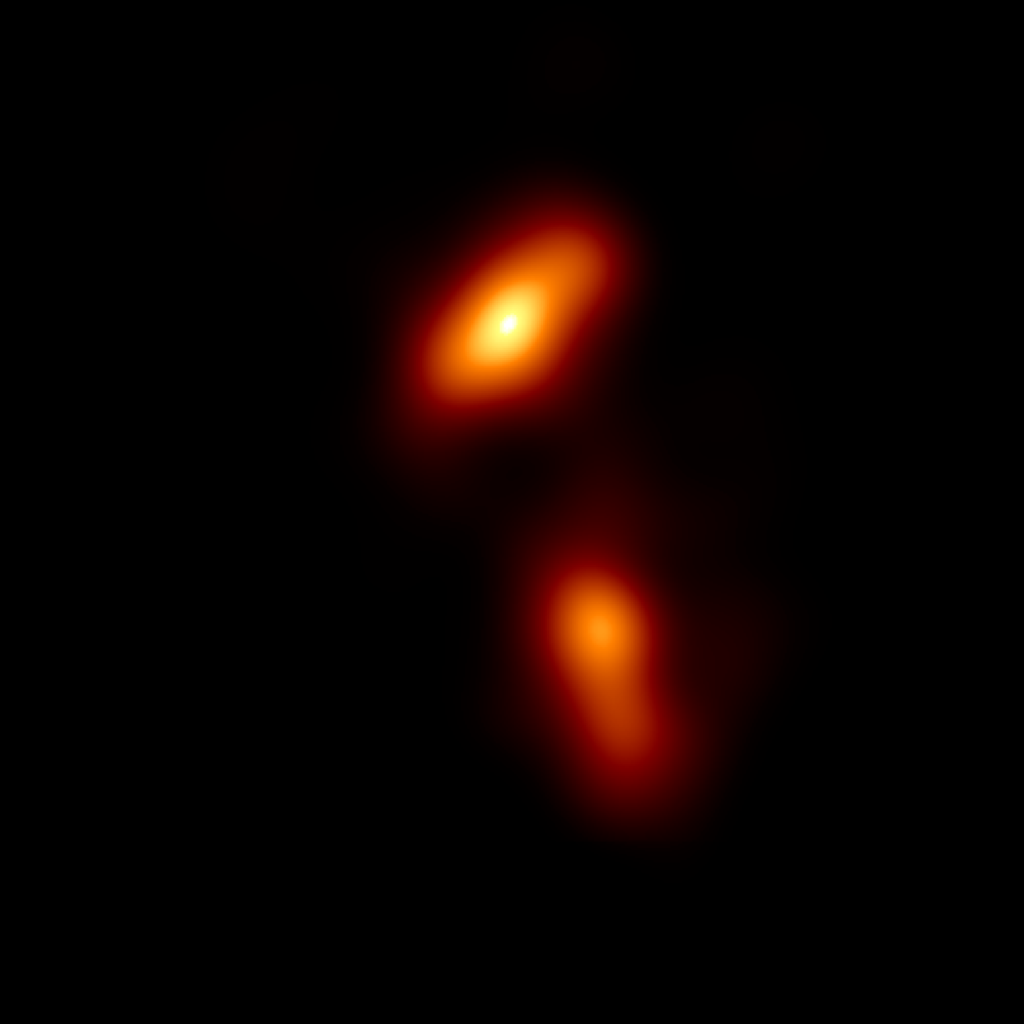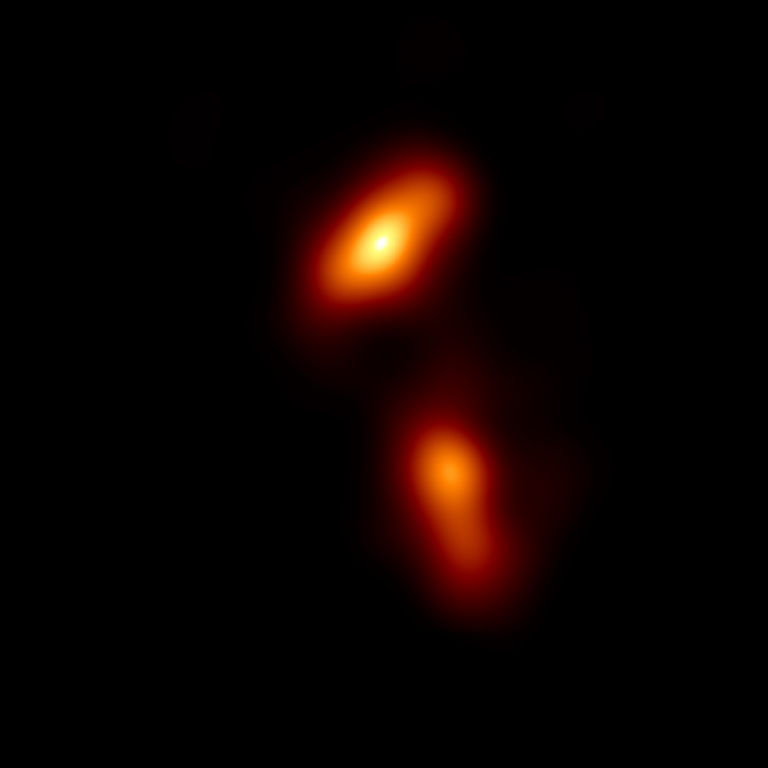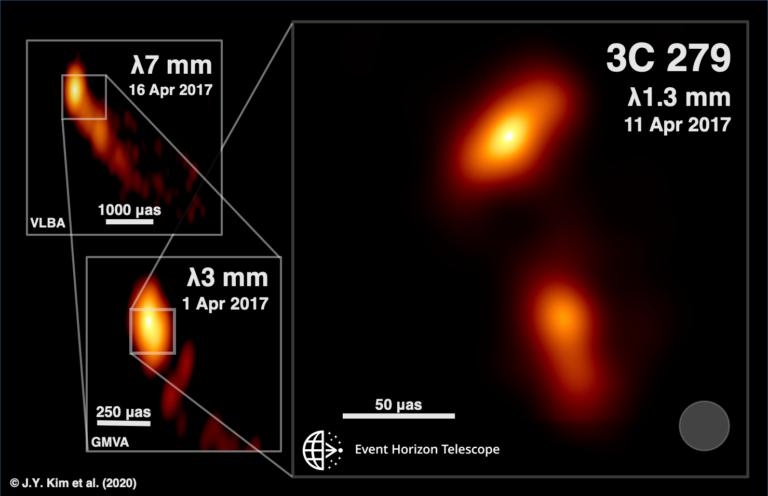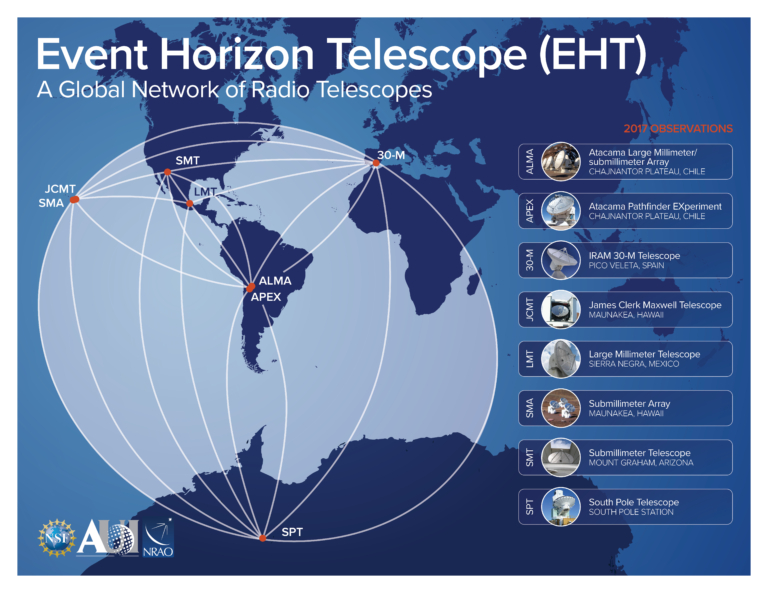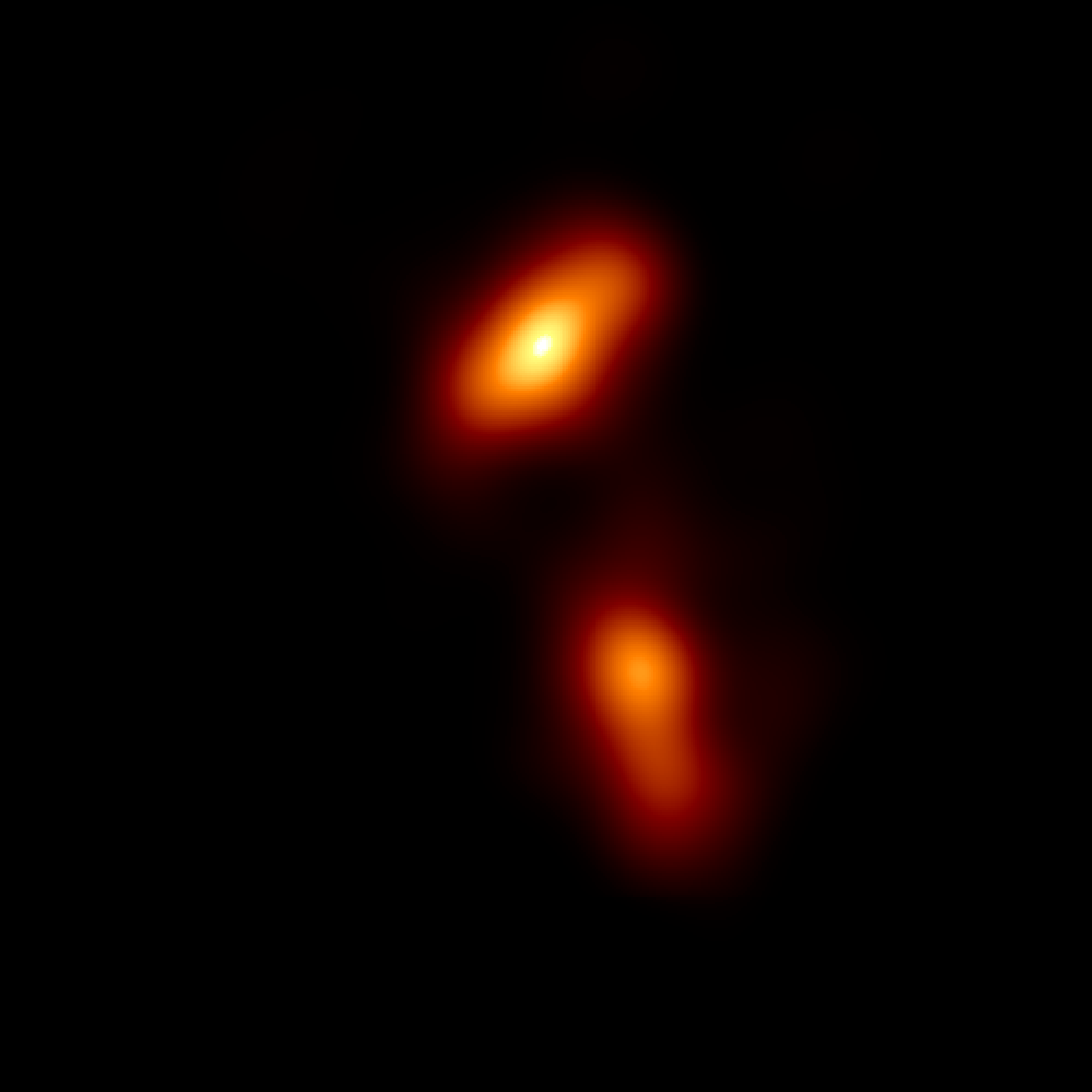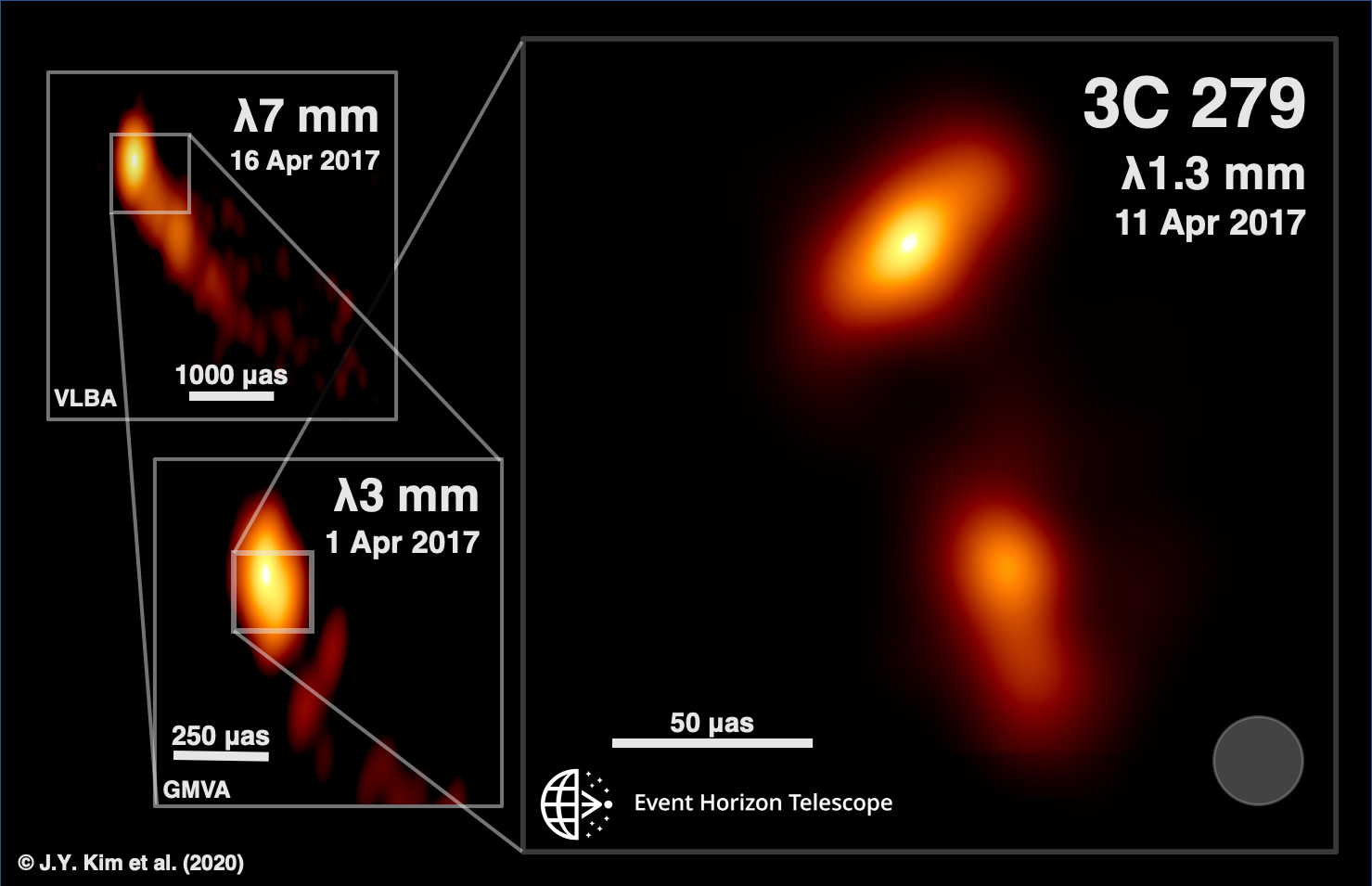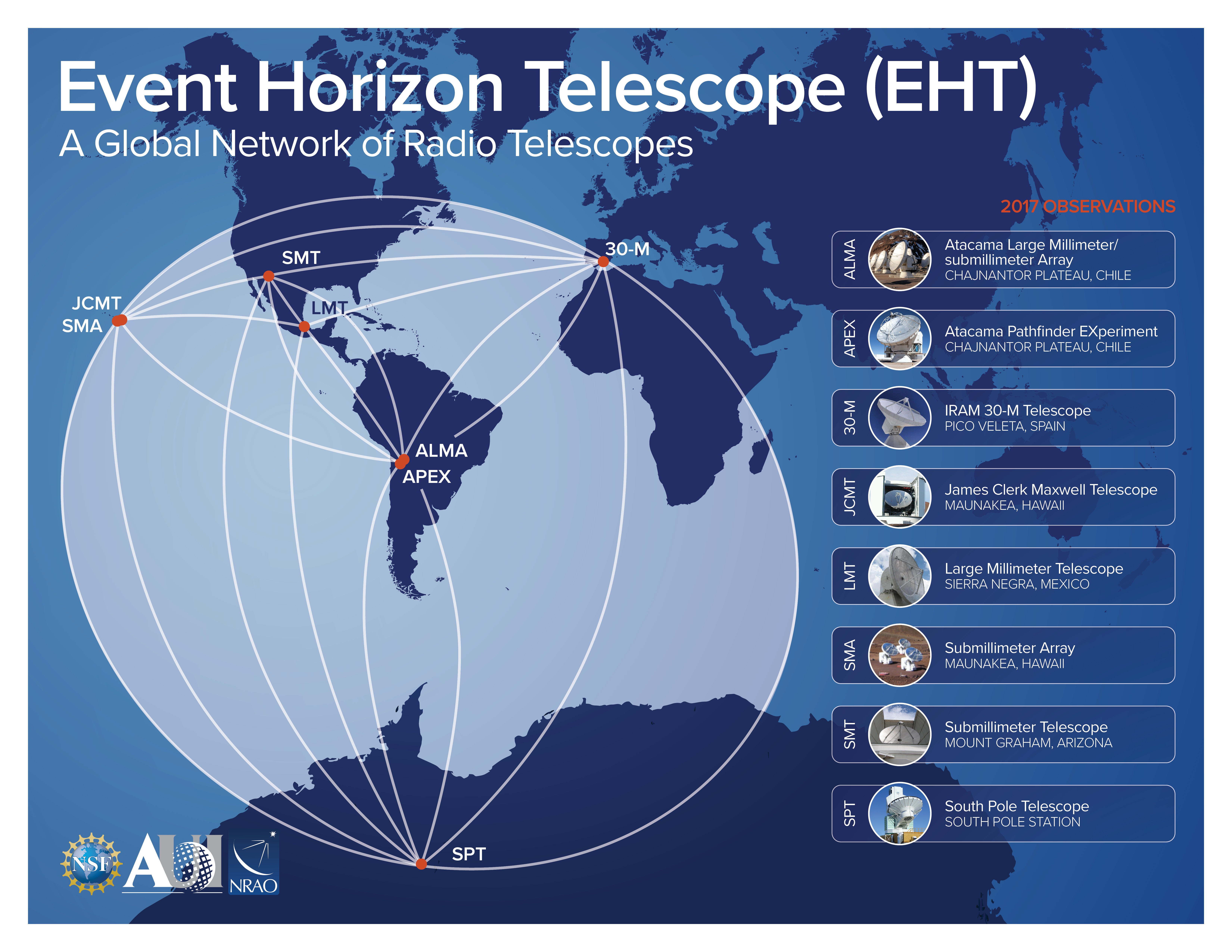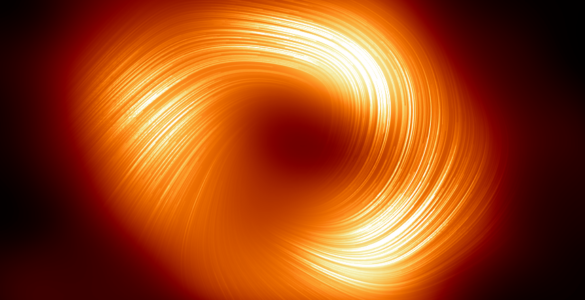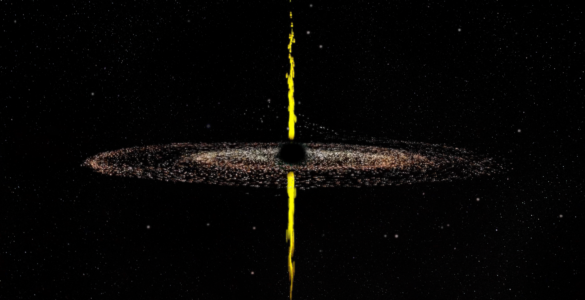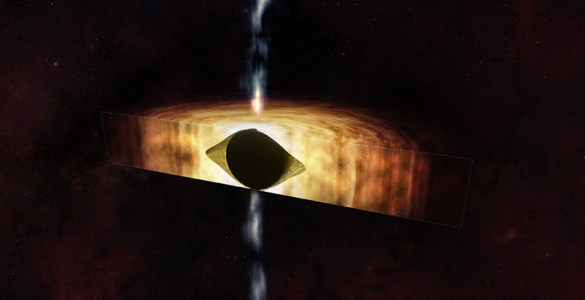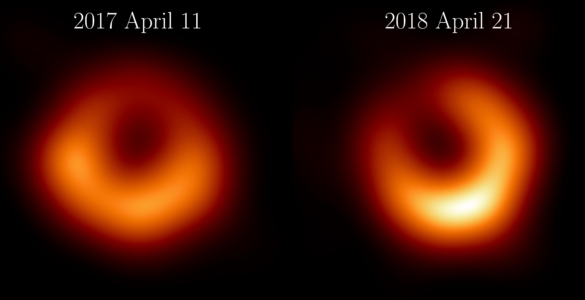One year ago, the Event Horizon Telescope (EHT) Collaboration published the first image of a black hole in the nearby radio galaxy M 87. Now the collaboration has extracted new information from the EHT data on the distant quasarQuasarAn apparently small (at least to observers on Earth) yet immensely powerful cosmic object. Some quasars (quasi-stellar objects, or QSOs) are strong radio sources. Radio-emitting quasars were the first to be discovered. These are some of the most distant objects in the Universe, and are believed to be fueled by supermassive black holes residing in ancient galaxies. 3C 279: they observed the finest detail ever seen in a jet produced by a supermassive black hole. New analyses, led by Jae-Young Kim from the Max Planck Institute for Radio Astronomy in Bonn, Germany, enabled the collaboration to trace the jet back to its launch point, close to where violently variable radiation from across the electromagnetic spectrum arises.
The results are published in the coming issue of “Astronomy & Astrophysics”, April 2020.
The EHT collaboration continues extracting information from the groundbreaking data collected in its global campaign in April 2017. One target of the observations was a galaxy 5 billion light-years away in the constellation Virgo that scientists classify as a quasar because an ultra-luminous source of energy at its center shines and flickers as gas falls into a giant black hole. The target, 3C 279, contains a black hole about one billion times more massive than our Sun. Twin fire-hose-like jets of plasma erupt from the black hole and disk system at velocities close to the speed of light: a consequence of the enormous forces unleashed as matter descends into the black hole’s immense gravity.
To capture the new image, the EHT uses a technique called very long baseline interferometry (VLBI), which synchronizes and links radio dishes around the world. By combining this network to form one huge virtual Earth-size telescope, the EHT is able to resolve objects as small as 20 micro-arcseconds on the sky — the equivalent of someone on Earth identifying an orange on the Moon. Data recorded at all the EHT sites around the world is transported to special supercomputers at the Max Planck Institute for Radio Astronomy in Bonn and at MIT’s Haystack Observatory in Westford, Massachusetts, where they are combined. The combined data set is then carefully calibrated and analyzed by a team of experts, which then enables EHT scientists to produce images with the finest detail possible from the surface of the Earth.
The newly analyzed data show that the normally straight jet has an unexpected twisted shape at its base. Jae-Young Kim, lead author of the paper, is enthusiastic and at the same time puzzled: “We knew that every time you open a new window to the universe you can find something new. Here, where we expected to find the region where the jet forms by going to the sharpest image possible, we find a kind of perpendicular structure. This is like finding a very different shape by opening the smallest matryoshka doll.”
“The results are very surprising,” said Kazunori Akiyama, a Jansky Fellow of the National Radio Astronomy Observatory (NRAO) at MIT Haystack who developed imaging techniques for the EHT to create the first images of the black hole in M87, and which were also used to create the images of quasar 3C 279. “When we observed the quasar for four days within one week, we assumed that we would not see these dynamical changes because the source is so far away (100 times further from Earth than M87). But the EHT observations were so sharp that for the first time we could see tiny changes in motions of the jets within this time frame.”
3C 279 has a very active nucleus that can be observed across all wavelengths. The jet in the nucleus has already been monitored for over two decades with the National Science Foundation’s Very Long Baseline Array (VLBA)Very Long Baseline Array (VLBA)An array of 10, 25 meter radio telescopes that stretches 8000km (5,000 miles) across North America.. Astronomers Alan Marscher and Svetlana Jorstad of Boston University lead a project called VLBA-BU-BLAZAR, to relate outbursts of gamma-rays and X-rays to changes in the jet seen in VLBA images at a wavelength of 7 millimeters.
The VLBA images reveal that 3C 279 shoots “blobs” of high-energy particles and magnetic fields down a jet at velocities up to 99.96% of the speed of light. “Surprisingly, the speeds vary over time, as does the direction that the blobs move when they first appear,” said Marscher. “This implies that the jets are propelled in a complex way from a jet launching region about 0.4 light-years across, which can be explored by shorter wavelength observations with the Event Horizon Telescope. The EHT observations have the potential to see how the blobs form and accelerate as they move farther from the black hole into the jet seen in the VLBA images.”
Avery Broderick, an astrophysicist working at the Perimeter Institute and University of Waterloo in Ontario, Canada, said: “For 3C 279, the combination of the transformative resolution of the EHT and new computational tools for interpreting its data have proved revelatory. What was a single radio ‘core’ is now resolved into two independent complexes. And they move – even on scales as small as light-months, the jet in 3C 279 is speeding toward us at more than 99.5% of light speed!”
Because of this rapid motion, the jet in 3C 279 appears to move at about 20 times the speed of light. “This extraordinary optical illusion arises because the material is racing toward us, chasing down the very light it is emitting and making it appear to be moving faster than it is,” clarifies Dom Pesce, a postdoctoral fellow at the Center for Astrophysics | Harvard & Smithsonian (CfA). The unexpected geometry suggests the presence of traveling shocks or instabilities in a bent, rotating jet, which might also explain emission at high energies such as gamma-rays.
“This result is a dream come true for anyone studying how jets are launched,” says Violette Impellizzeri, lead astronomer for the Atacama Large Millimeter/submillimeter Array (ALMA)Atacama Large Millimeter/submillimeter Array (ALMA)Funded by the U.S. National Science Foundation and its international partners (NRAO/ESO/NAOJ), ALMA is among the most complex and powerful astronomical observatories on Earth or in space. The telescope is an array of 66 high-precision dish antennas in northern Chile. VLBI observations. “I am particularly thrilled to have been supporting these observations. I did my PhD with this group and we were already working hard on resolving the jet foot point already 15 years ago. With the help of ALMA and all others telescopes in the array, the EHT is really getting there!”
The EHT array is always improving, explains Shep Doeleman, EHT Founding Director. “These new quasar results demonstrate that the unique EHT capabilities can address a wide range of science questions, which will only grow as we continue to add new telescopes to the array. Our team is now working on a next-generation EHT array that will greatly sharpen the focus on black holes and allow us to make the first black hole movies.”
The telescopes contributing to this result were ALMA, Atacama Pathfinder Experiment (APEX), the IRAM 30-meter telescope, the James Clerk Maxwell Telescope, the Large Millimeter Telescope, the Submillimeter Array, the Submillimeter Telescope, and the South Pole Telescope.
Reference
J.Y. Kim, T.P. Krichbaum, A.E. Broderick, et al.: Event Horizon Telescope imaging of the archetypal blazar 3C 279 at an extreme 20 microarcsecond resolution, in: Astronomy & Astrophysics, April 2020. https://doi.org/10.1051/0004-6361/202037493
Media contact
Iris Nijman
NRAO News and Public Information Manager
inijman@nrao.edu
Background Information
The international collaboration announced the first-ever image of a black hole at the heart of the radio galaxy Messier 87 on April 10, 2019 by creating a virtual Earth-sized telescope. Supported by considerable international investment, the EHT links existing telescopes using novel systems — creating a new instrument with the highest angular resolving power that has yet been achieved.
The individual telescopes involved in the EHT collaboration are: the Atacama Large Millimetre Telescope (ALMA), the Atacama Pathfinder EXplorer (APEX), the Greenland Telescope (since 2018), the IRAM 30-meter Telescope, the IRAM NOEMA Observatory (expected 2021), the Kitt Peak Telescope (expected 2021), the James Clerk Maxwell Telescope (JCMT), the Large Millimeter Telescope (LMT), the Submillimeter Array (SMA), the Submillimeter Telescope (SMT), and the South Pole Telescope (SPT).
The VLBA-BU-BLAZAR project has been supported by the National Science Foundation and NASA’s Fermi guest investigator program.
The Atacama Large Millimeter/submillimeter Array (ALMA), an international astronomy facility, is a partnership of the European Organisation for Astronomical Research in the Southern Hemisphere (ESO), the U.S. National Science Foundation (NSF) and the National Institutes of Natural Sciences (NINS) of Japan in cooperation with the Republic of Chile. ALMA is funded by ESO on behalf of its Member States, by NSF in cooperation with the National Research Council of Canada (NRC) and the Ministry of Science and Technology (MOST) and by NINS in cooperation with the Academia Sinica (AS) in Taiwan and the Korea Astronomy and Space Science Institute (KASI).
ALMA construction and operations are led by ESO on behalf of its Member States; by the National Radio Astronomy Observatory (NRAO), managed by Associated Universities, Inc. (AUI), on behalf of North America; and by the National Astronomical Observatory of Japan (NAOJ) on behalf of East Asia. The Joint ALMA Observatory (JAO) provides the unified leadership and management of the construction, commissioning and operation of ALMA.
The National Radio Astronomy Observatory is a facility of the National Science Foundation, operated under cooperative agreement by Associated Universities, Inc.


